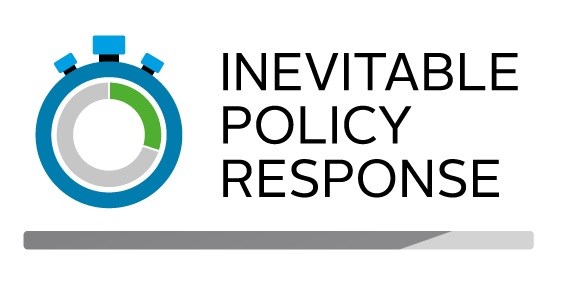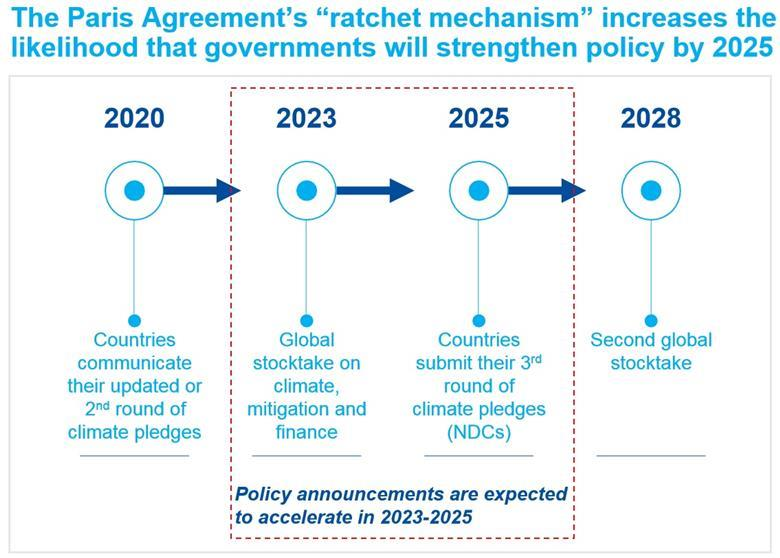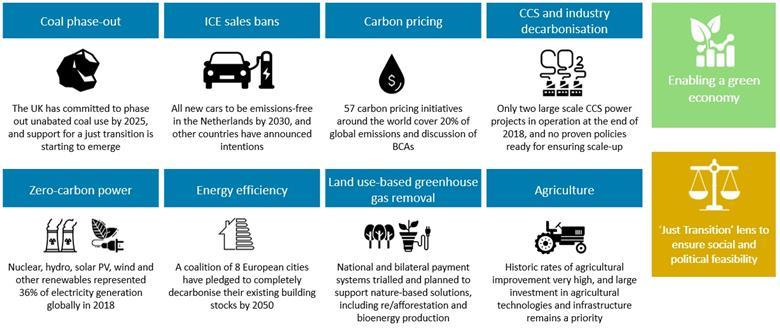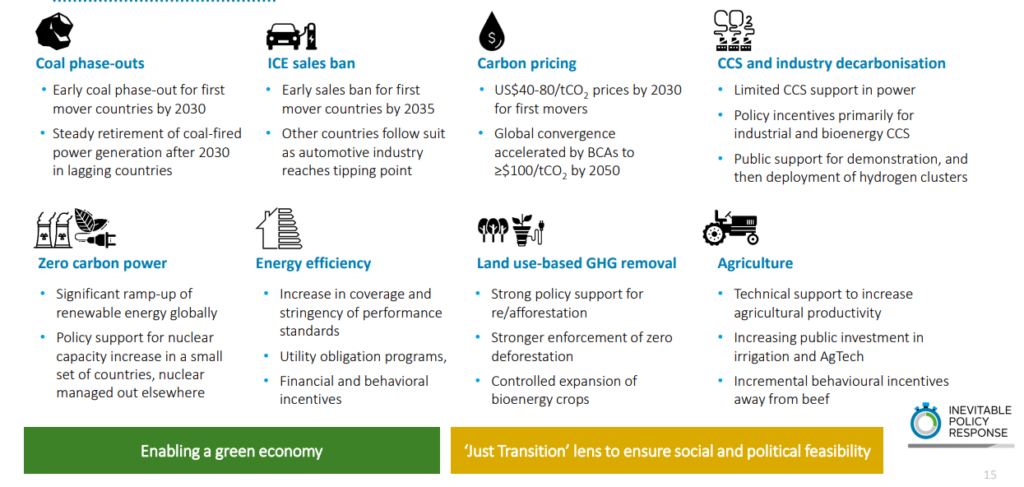
This is a series of three installments. This first looks at what is meant by the ‘Inevitable Policy Response’. And the second and third look at how that could translate into the sphere of consumer goods industries.
We all can see it happening before our eyes: Despite the Paris Climate Agreement to a climate trajectory of ‘well bellow’ 2 degrees (hence where the 1.5C number stems from) – the trajectory is not anywhere near that number.
By and large that can mean one of two things:
- We go on as we do globally so far, hoping for the best, and just accepting that we steer towards a future that while unknown in detail, will be a tough nut to crack in terms of survival and adaptation [insert some of the known consequences here].
- At one point in a not to far away future, legislation will kick in to make up for the delay in the delivery schedule to the 1.5 degree trajectory. Because politicians cannot look away any more and have citizens breathing down their neck.
Inevitable Policy Response (IPR): The 5WH
The UN PRI (Principles for Responsible Investment) have looked at the 2nd of the above scenarios in further detail. Both, in terms of WHAT it will possibly entail, as well as in terms of WHEN this is could be happening.
The sobering realisation is that WHAT will happening could be dramatic in terms of impact on business (and in extension citizens) and as to HOW it will happen: abrupt, fast and furious.
This second of the above scenarios is what is called the ‘Inevitable Policy Response’.
In the rest of this post we will be looking into what the PRI outlines (first instalment). In the second instalment we will then have a thought about how those insights translate beyond the PRI’s target public – investors – into the sphere of consumer goods industries. But first things first: Let’s deep dive into what is mean by the Inevitable Policy Response and the context around it.
What is the Inevitable Policy Response (IPR) exactly?
The Inevitable Policy Response (IPR) is the response by governments and legislators around the globe in taking action – hence enacting laws – in line with the 1.5 Degree climate goals.
As a whole, the IPR is a scenario forecasting exercise – which however, and given the relatively short time frame it covers, is much driven my much harder data, and fewer potential pathways, then is typically the case for longer range scenarios (e.g. 20, 30, 50 year time ranges).
At its outset, it is design for the investment community. And this for a number of reasons. The most important of which is the restructuring and risk proofing of their portfolios, many of which not only take a long-range view on profit, but also require some time for restructuring and alignment with such challenging risk scenarios as they are expected to become reality.
Why is it expected to happen? Who is the actor? And Who the affected?
The IPR is expected to be ‘inevitable’ due to exponentially mounting public and factual pressures: citizens, economic players requiring a level playing field, and – of course – ever worrying climate data. In other words: The realities of climate change will inevitably catch up with governments across the globe – and compel them to become active.
That governments up to this point have been slow in – or even absent from – Climate Action is old news. Chances are however that this may not stay the same. Pressure for policy action will continue to increase and come from all angles – environmental, social, and economic – fuelled by fears over national security; enabled by advances in technology and upward pressure by electorates and businesses to act. And that eventually – governments will bend to the pressures.
When is it expected to happen?
The expectations are that while this will still be taking a bit – hence loosing us valuable time – the consequences will be swift, drastic, and potentially quite brutal for both citizens and as well as economic players in equal terms.
At this moment, and due to the current political situations around the globe, the expectations are that pressures mount exponentially around the 2023 mark – the 1st evaluation point of the Paris Climate Agreement – leading to drastic legislative action around the 2025 mark. This in order for the 2028 2nd stocktake of the Paris Agreement to be at least prospectively more in line with what is needed in terms of climate trajectory.

Where will it happen? And Where will it show effect?
While drastic action is not expected until the mid of this decade, some levers start to show already now (see illustration hereafter) in decisions being taken by local governments and investors, and also public discourse.

But evidently it is not “just’ whole industries and economic players that will in the spotlight or at the heart of the action. Governments around the globe will take action to protect their citizens, their territory and their economic and other resources.
How could the effects look like?
This is where it gets really interesting, and maybe also most concrete, as the PRI has developed a small range of fairly concrete scenarios on how such a drastic action by governments around the globe could pan out.

As the PRI originally developed their insights targeting the financial and investment sector, their focus industries are – unsurprisingly – energy, transport and agriculture. The following are the 4 + 2 + 3 take home insights (Source) that emerge from their analysis:
Deep and rapid changes in the energy system
- Oil peaks between 2026-28, driven by a 65% decline in demand from vehicles with internal combustion engines between 2025-2050. Oil in road transport peaks in 2025.
- Thermal coal for electricity generation has reached its peak, and declines rapidly by an average of 6 percentage points per year from 2025 to 2040 at which point it is virtually non-existent
- Natural gas peaks around 2040, playing a role in reducing emissions from heating and decarbonising industry until it is starting to be replaced by zero-carbon electricity from hydrogen from 2040 onwards
- Solar and wind alone will be generating approximately half of all electricity in 2030 and two-thirds of all electricity by 2050. The Forecast Policy Scenario (FPS) expects 74% of power will come from renewables (solar, wind, hydro and others) in 2040.
Transport electrified inside 20 years
- Vehicles powered by internal combustion engines (ICE) sharply decline from 2025 and by 2040 ultra-low emissions vehicles outnumber ICE vehicles two to one, driven by 2035 ICE sales bans in Western Europe and China, and 2040 sales bans in USA, Japan and other regions
- ICE sales bans, supported by falling cost of EVs, drive rapid deployment of ultra-low emissions vehicles, making up almost 70% of passenger vehicles by 2040.
Deforestation virtually eliminated by 2030, with forests recovering to 1995 levels during the following decade.
- This drives big changes for agricultural commodity supply chains as they adjust to stricter controls on deforestation
- Competition for land results in a significant increase in investments in yield-enhancing technologies, boosting food productivity by 58% between 2020 and, helping to lower food prices as a proportion of household expenditure (from 4.8% to 3.8%) as GDP per capita grows
- Wider land use shifts include growth in bioenergy crops which meet around 10% of global energy demand by 2050
In addition to the above, PRI makes a point in stating that the global economic impact will be significant:
“The analysis shows that these critical policies could permanently wipe between 3.1 and 4.5 percent or $1.6tn to $2.3tn off the valuation of a range of companies in the MSCI ACWI index, depending on the timing of repricing. One in five companies are impacted by at least 10% in either direction. The impact is equivalent to the largest 12 to 33 companies on the FTSE100.” (Source)
And Yet: It remains a rocky road ahead
The even more troublesome news is that despite all the urgent measure we can expect to happen in a relatively short time-frame … more will happen. It is just a lot less clear what that could be and how the exact impacts could look like.
Because while a >60% emission reduction is possibly going to happen until 2050, it is by far not enough to be on a 1.5C climate trajectory … which is what will be THE global goal. Additional policy responses will hence happen, equally invariably. It is just much less clear either how they look like or what their impact could possibly result in.
More on the Inevitable Policy Response directly from the PRI:
- PRI Website: https://www.unpri.org/inevitable-policy-response/what-is-the-inevitable-policy-response/4787.article
- The full report: https://www.unpri.org/download?ac=9832
- The Executive Summary: https://www.unpri.org/download?ac=9831
- Webcast: https://www.unpri.org/the-inevitable-policy-response-preparing-investors-for-an-abrupt-transition/5304.article (upon free registration)
Video: PRI Climate Forum London, 26 November 2018. The Inevitable Policy Response
The upcoming second and third installments will reflect upon how the ‘Inevitable Policy Response’ could potentially impact consumer good industries.

